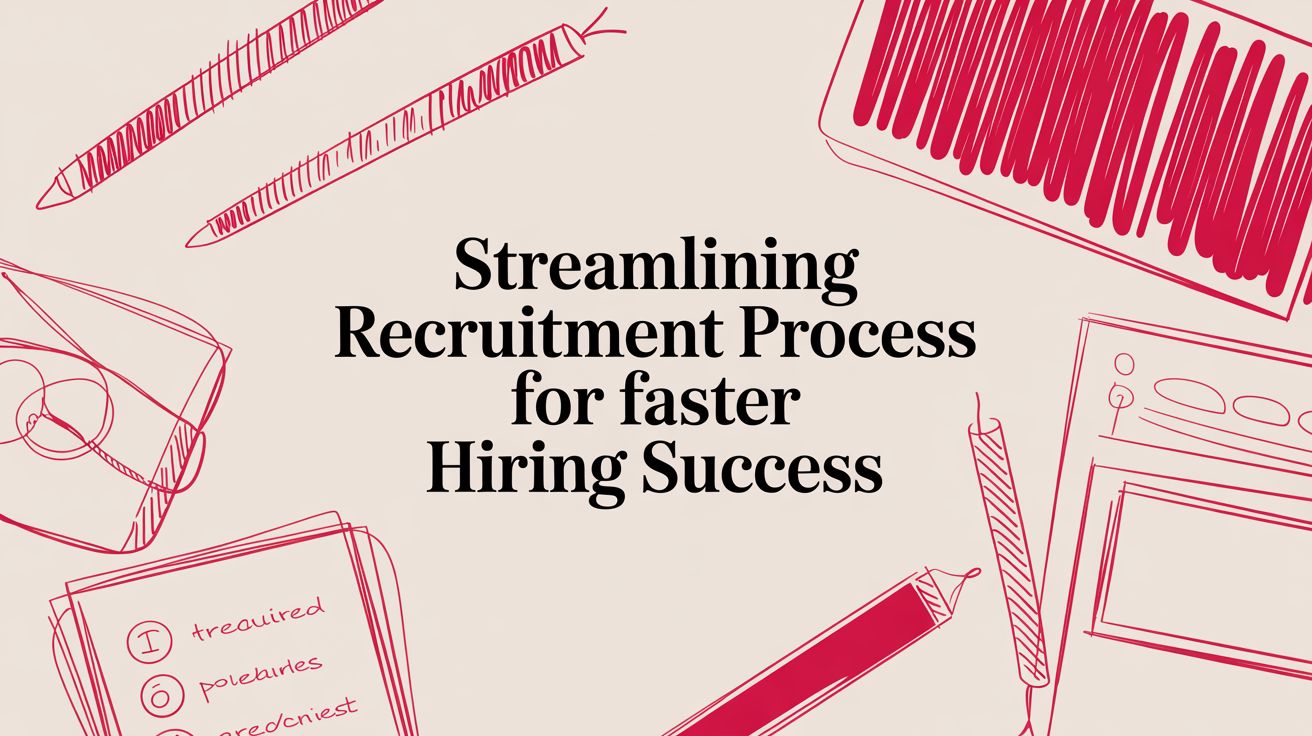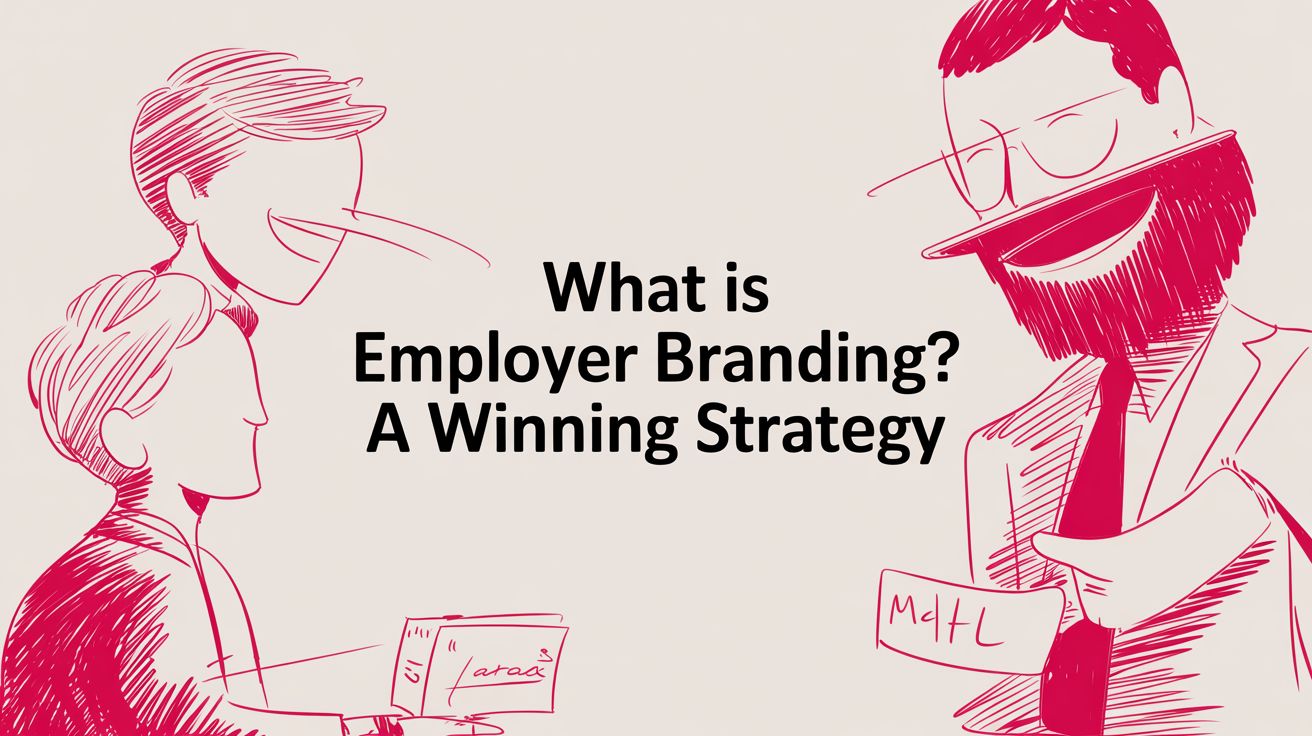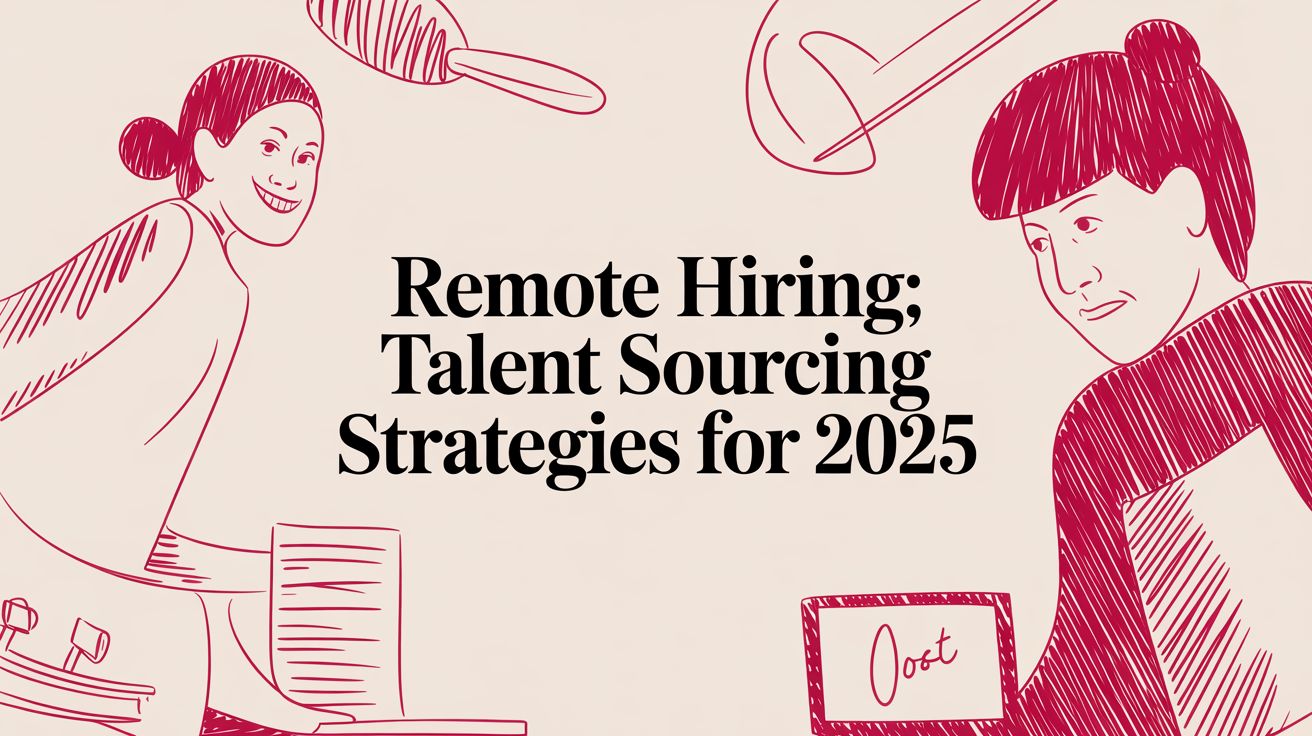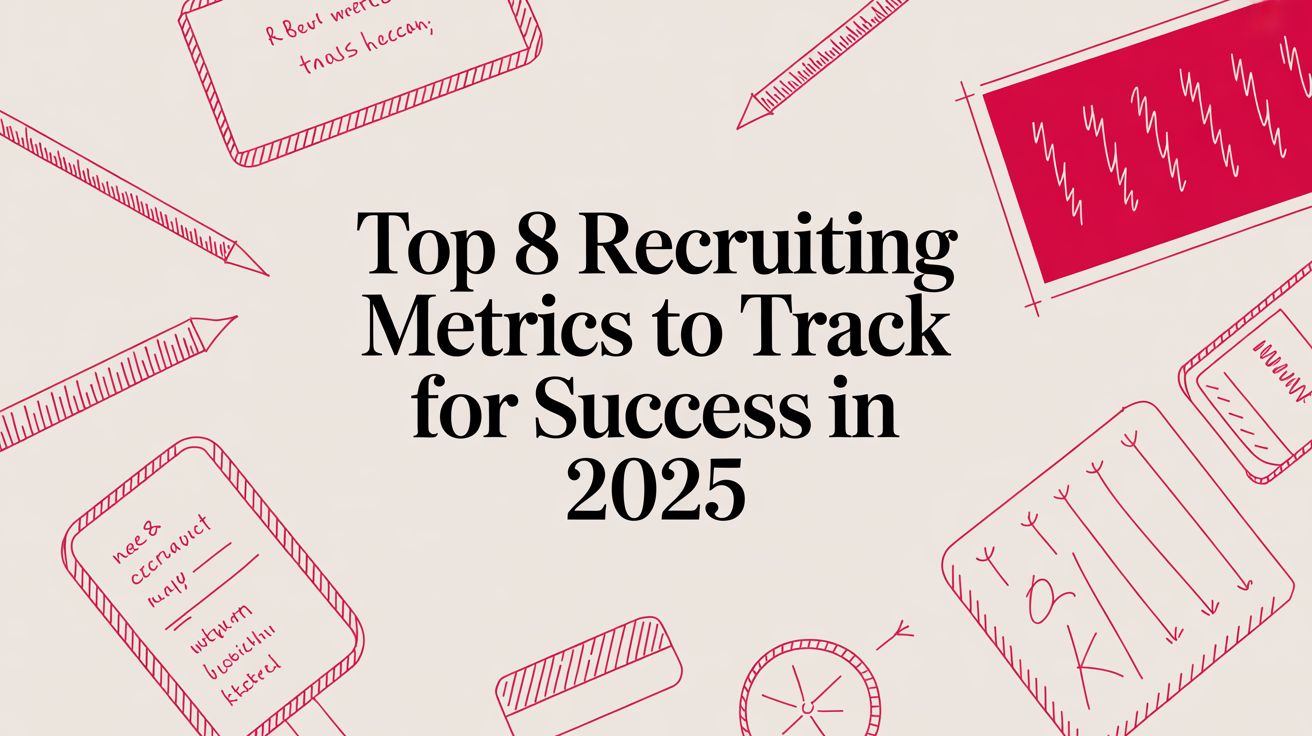Let’s be honest, trying to manage hiring with a spreadsheet just doesn’t cut it anymore. A proper recruitment software comparison is the first step in moving your company from clunky, manual processes to a smart, automated platform. The right tool won’t just organize your applicants; it will streamline your entire workflow, slash hiring costs, and deliver the kind of data you need to actually improve how you find talent.
Why You Can’t Afford to Ignore Modern Recruitment Software
The way we hire has completely changed. Those legacy systems and manual tracking methods that kind of worked a few years ago are now major roadblocks in a fiercely competitive talent market. Spreadsheets are a nightmare for version control, prone to human error, and offer zero automation or real-time collaboration for a distributed team. It’s an outdated approach that creates administrative bottlenecks and slows everything down.
In stark contrast, modern recruitment software is your central command center for hiring. These platforms are built from the ground up to handle the messy reality of today’s hiring environment, which is all about global talent pools and the unstoppable rise of remote work trends. They give your team the power to move faster and make smarter, data-driven decisions instead of just guessing.
From Digital Filing Cabinets to Intelligent Hiring Engines
The leap from simple Applicant Tracking Systems (ATS) to intelligent talent acquisition platforms is a massive one. The first generation of these systems were basically digital filing cabinets—great for storing and organizing resumes, but they didn’t do much to proactively make your hiring better.
Today’s solutions are a world away from that basic tracking. They’re packed with advanced features that actively improve every single stage of the hiring process:
- AI-Powered Sourcing: Think of tools that automatically scan candidate databases and job boards to surface the best-fit people before you even start searching.
- Workflow Automation: This is where you reclaim your time. These features handle the repetitive stuff like scheduling interviews, sending out rejection emails, and moving candidates along in the pipeline.
- Deep Analytics: Finally, you get real answers. Dashboards show you crucial metrics like time-to-hire, cost-per-hire, and which sources are actually delivering quality candidates.
- Candidate Relationship Management (CRM): This is all about playing the long game by building and nurturing relationships with great candidates who might not be a fit now, but could be perfect for a future role.
This screenshot gives you a glimpse into a typical workflow inside an Applicant Tracking System, showing how candidates are visualized as they move through different stages.
That simple visual pipeline shows you exactly what a spreadsheet can’t: at-a-glance visibility into your entire hiring process.
The Market Boom and Why It Matters to You
This isn’t just a niche trend; it’s a massive market shift. The global recruitment software market was valued at around US$3.30 billion in 2025 and is on track to blow past US$6.20 billion by 2032. That explosive growth, representing a compound annual growth rate of roughly 9.4%, tells a clear story: businesses everywhere are recognizing these tools are no longer optional.
If you want to dig deeper, you can explore recent analyses of recruitment software market trends. A solid recruitment software comparison isn’t just about picking a new tool—it’s a strategic investment in building a more agile and competitive team.
Establishing Your Core Evaluation Criteria
Hopping on a bunch of demos without a clear game plan is a classic recipe for confusion. Before you even start comparing recruitment software, you need to build your own evaluation framework—a personalized scorecard, really. This becomes your North Star, making sure you’re judging each platform on what your company actually needs, not just on a slick sales pitch.
This whole process starts with a hard look at your current hiring headaches and where you see the company going. A tool that’s a perfect fit for a five-person startup will almost certainly fall flat for a 500-person enterprise. Your criteria have to match your unique reality, from how many people you hire to how complex your internal approval chains are.
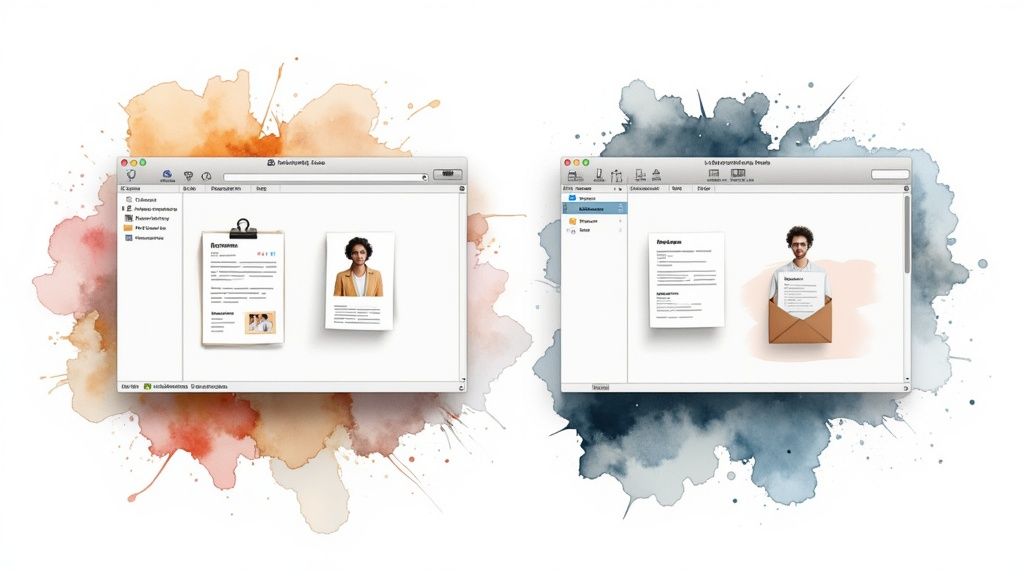
Defining Your Non-Negotiable Features
First things first: list out the absolute must-haves. This isn’t a wish list of cool gadgets; it’s the core functionality your team can’t live without. Think about the daily grind—what tasks eat up the most time, and which features would directly solve those problems?
You can start by thinking through these essential categories:
- Workflow Automation: Can it handle the repetitive stuff? Think automated interview scheduling, templated candidate emails, and nudges to hiring managers. The goal here is to kill the manual tasks that slow everyone down.
- Collaboration Tools: How easy is it for the whole team to work together? Look for simple ways to share candidate profiles, leave notes for each other, and collect feedback from different interviewers without a million emails.
- Candidate Sourcing: What’s in the toolkit for finding people who aren’t actively looking? You’ll want to see things like browser extensions for grabbing profiles, resume parsing, and solid integrations with the job boards you use.
A huge piece of this puzzle is how any feature impacts the person applying for the job. A clunky, confusing system can turn off great candidates before you even speak to them. Taking a moment to understand https://remotefirstjobs.com/blog/what-is-candidate-experience is crucial—the right software should make it better, not worse.
Assessing Integration and Scalability
A recruiting platform can’t live on an island. It has to play nice with the other HR tech you’re already using. Seamless integrations are what prevent data from getting trapped in silos, giving you a single, reliable source for all your people information.
Before you look at any new tools, map out your current tech stack.
- HRIS (Human Resource Information System): The new software absolutely must be able to push new hire info directly into your core HR system to kick off onboarding automatically.
- Productivity Tools: Does it integrate with your team’s email, calendars, and chat platforms like Slack or Microsoft Teams? Embedding hiring tasks into the tools you already use every day is a game-changer.
- Assessment Platforms: If you rely on skills tests or video interviewing tools, make sure there are native integrations so you’re not stuck with clunky workarounds.
At the same time, you have to think about what happens when you grow. Ask vendors how their pricing and features scale up. A platform that’s affordable now could get incredibly expensive once you add more recruiters or your hiring numbers spike. You need a solution that works for you not just this year, but five years from now. As you think about this, it can also be helpful to read up on the best business process automation tools to get a broader sense of what really drives efficiency as a business scales.
Analyzing the Top Recruitment Platforms
Choosing the right recruitment software is more than just ticking off features on a list. It’s about finding a platform that actually fits how your team works. I’m going to give you a straight-up, head-to-head analysis of four of the biggest names in the game—Greenhouse, Lever, Workable, and Ashby—and dig into how they perform in the real world. We’ll look at the core functions that matter for modern hiring.

This isn’t just a product tour. Think of it as a strategic guide to matching a platform’s strengths with your specific hiring headaches, especially if you’re a distributed or remote-first company. The goal here is clarity, not just more options.
Candidate Sourcing and Engagement
Finding and connecting with top talent is where it all begins. Good software doesn’t just track who applied; it actively helps you build a healthy pipeline of both active job seekers and passive candidates. Each of these platforms tackles this challenge in a completely different way.
Greenhouse is the go-to for structured, enterprise-level sourcing. Its real power is in managing complex referral programs and plugging into a huge marketplace of third-party sourcing tools. For big organizations that need to track every candidate source with surgical precision for reporting and compliance, Greenhouse gives you that unmatched control.
Lever, on the other hand, is built around its native Candidate Relationship Management (CRM). It fundamentally treats every person—whether they applied or you sourced them—as part of a long-term talent pool. The platform’s “Nurture” campaigns are a standout feature, letting recruiters build and maintain relationships over time. This is perfect for companies that are serious about building talent communities.
A key difference here is the philosophy. Greenhouse is pipeline-centric, all about moving active applicants through stages. Lever is candidate-centric, focusing on the long-term relationship. It’s a subtle distinction, but it makes a huge difference in how you recruit proactively.
Workable is a fantastic choice for small to medium-sized businesses (SMBs) that just need to get their jobs out there, fast. It offers one-click posting to over 200 job boards and uses its own AI to source candidates from a massive database. Its simplicity and reach make it a powerhouse for teams that don’t have dedicated sourcing specialists.
Ashby is the data-driven newcomer, and it brings some serious firepower to sourcing analytics and automation. It lets recruiters build out complex, multi-step email sequences, track engagement metrics like open and reply rates, and automate all the follow-ups. This makes it a perfect match for high-growth tech companies that run their recruiting like a sales operation.
Workflow Automation and Collaboration
Once you’ve got candidates in the pipeline, efficiency is everything. The right software gets rid of the repetitive tasks and makes it dead simple for hiring managers, interviewers, and recruiters to stay on the same page. This is absolutely critical for remote teams who can’t just swing by someone’s desk.
Greenhouse excels with its highly customizable, stage-based workflows and structured interview kits. It enforces consistency across the entire hiring process, which is essential for large, distributed teams trying to maintain quality and reduce bias. Its approval flows also ensure every job req and offer letter follows a specific chain of command.
Lever takes a more flexible approach with a visual pipeline that you can easily customize with drag-and-drop. Collaboration feels really intuitive, with features like @-mentions and a unified “story” for each candidate that pulls together every email, note, and piece of feedback. It feels less rigid and more adaptable for teams that need to move quickly. If your company culture leans heavily on team-based hiring, you might also get some good ideas from our guide on the best https://remotefirstjobs.com/blog/tools-for-remote-teams.
The global recruitment software market is growing for a reason—efficiency is in high demand. A recent analysis valued the market at about USD 2.38 billion in 2024, and it’s projected to hit USD 3.7 billion by 2033. North America is leading the charge with a 35.3% market share, largely because so many companies, especially SMEs, have adopted cloud-based hiring platforms.
Analytics and Reporting Capabilities
You can’t fix what you can’t measure. Strong analytics are what turn recruiting from a reactive function into a strategic one. This is where you find the data to optimize your sourcing channels, pinpoint bottlenecks, and make decisions backed by actual numbers.
Greenhouse provides robust, standard reporting dashboards that cover all the essentials like time-to-fill and source effectiveness. For enterprise clients, its ability to generate detailed reports for diversity, equity, and inclusion (DEI) initiatives is a huge selling point.
Lever offers up visually clean dashboards that are easy for the whole team to grasp. It focuses on full-funnel analytics, clearly showing you the conversion rates at every single stage of your pipeline. This helps your team quickly spot where candidates are dropping off and figure out why.
Workable keeps its reporting straightforward, geared perfectly for the needs of SMBs. It gives you clear, actionable reports on hiring velocity and costs without drowning you in data you don’t need. For teams that need quick insights, its simplicity is a feature, not a bug.
Ashby, however, is in a completely different league when it comes to analytics. The entire platform was built with a data-first mindset. It offers completely customizable reporting and advanced metrics you won’t find elsewhere, like interviewer load balancing, pass-through rates by individual interviewer, and detailed ROI on every sourcing channel. For teams that live and breathe data, Ashby provides a depth that others just can’t touch. When you’re looking at the top platforms, it’s always a good idea to check out comparisons of the best recruitment automation software to see how the market leaders stack up.
Feature Comparison of Leading Recruitment Software
To pull all this together, here’s a side-by-side table that breaks down the key differences, focusing on the features that are most critical for modern, remote-first hiring.
| Feature Category | Greenhouse | Lever | Workable | Ashby |
|---|---|---|---|---|
| Best For | Structured, enterprise-scale hiring and compliance. | Relationship-driven recruiting and collaborative teams. | SMBs needing speed, reach, and an all-in-one solution. | Data-centric, high-growth companies with advanced needs. |
| Sourcing Strength | Deep integrations and robust referral management. | Native CRM with powerful candidate nurturing features. | One-click posting to 200+ job boards and AI sourcing. | Advanced sourcing automation and deep analytics. |
| Workflow Style | Highly structured and permission-based workflows. | Flexible, visual pipeline with intuitive collaboration. | Simple, easy-to-use workflows for fast hiring. | Highly automated and customizable for efficiency. |
| Analytics Focus | Comprehensive standard reports, strong on DEI metrics. | Visual, full-funnel analytics for pipeline health. | Clear, essential reports on speed and cost. | Deeply customizable, granular reporting on every metric. |
Ultimately, the best platform for you really depends on your company’s size, your hiring maturity, and what you’re trying to achieve. Each one of these tools is incredibly powerful when it’s put in the right hands.
Matching Software to Your Business Needs

After looking at dozens of recruitment platforms, one thing becomes crystal clear: there’s no such thing as the “best” one. The right software is the one that fits your company’s reality—your size, hiring pace, industry, and bigger strategic goals. A tool that’s perfect for a scrappy startup could easily bog down a large enterprise, and the reverse is just as true.
This section cuts through the generic feature lists to give you practical, situational advice. We’ll break down a few common business profiles to help you pinpoint which type of software makes the most sense for how you actually operate. It’s all about focusing on real-world scenarios to make your decision easier.
For the High-Growth Startup
Startups live in a state of controlled chaos. Speed, flexibility, and the ability to scale are everything. Your hiring process has to be just as nimble, capable of absorbing a sudden surge in headcount without getting buried in admin work. You need a tool that can keep pace.
In this environment, you’re looking for something with serious automation capabilities that’s also dead simple to use. Your team doesn’t have weeks to spend on training or a complex implementation.
Look for platforms that deliver:
- Quick Onboarding: Systems you can get up and running in days, not months.
- Intuitive User Interface: A clean dashboard that recruiters and hiring managers can figure out with minimal hand-holding.
- Powerful Automation: Automated interview scheduling, candidate messaging, and pipeline movements are non-negotiable. They are massive time-savers.
A platform like Lever really shines here. Its candidate-first design and easy collaborative features help fast-moving teams deliver a great candidate experience, even when they’re hiring like crazy. Ashby is another fantastic choice, especially for tech startups that geek out on deep analytics and automated sourcing.
For the Established Enterprise
Large organizations play a completely different game. Their hiring processes are often layered and complex, with strict approval workflows, tough compliance standards, and an absolute need for data security. Your software’s job is to enforce structure and consistency across a large, distributed team.
Here, the top priorities shift to customization, robust reporting, and security. The ideal enterprise tool gives you granular control over every single step of the hiring journey.
Key Enterprise-Grade Features:
- Configurable Workflows: The power to build custom hiring stages, scorecards, and approval chains that mirror your company’s internal processes.
- Advanced Security and Compliance: Granular user permissions, data encryption, and support for regulations like GDPR are must-haves.
- Comprehensive Reporting: The ability to pull detailed reports on everything from source of hire to diversity and inclusion metrics.
Greenhouse is the classic example of a platform built for this kind of structure and scale. Its highly configurable system is designed to maintain consistency and compliance, making it a go-to for large companies managing complex hiring operations.
For the Small Business or Agency
Small businesses and recruiting agencies need an all-in-one solution that packs a punch without the enterprise price tag or a dedicated IT team to run it. The goal is efficiency and reach—finding a tool that amplifies a small team’s efforts so they can compete with the big players.
The evolution of recruitment tech has been huge for smaller companies. The global market for these tools shot up from USD 1.75 billion in 2017 and is projected to hit USD 3.1 billion by 2025, largely because of the demand for more accessible, powerful platforms. You can dig into these recruitment software market trends to see just how much the landscape has opened up.
The best software in this category bundles multiple functions into one affordable package. Look for:
- Integrated ATS and CRM: A single system to manage active applicants and nurture your passive talent pool.
- Broad Job Board Distribution: The ability to post a job to dozens of job boards with a single click is a game-changer.
- Strong Employer Branding Tools: Features that help you build a compelling careers page are vital. If you need a hand with this, check out our guide on employer branding best practices.
Workable is often the top pick in this space. Its friendly interface, smart AI-powered sourcing, and massive job board network give small businesses the firepower they need to find great people without breaking the bank. By matching your business profile to a platform’s core strengths, you turn your software search into a strategic decision—ensuring you invest in a tool that will actually help your team win.
Planning Your Implementation and Adoption Strategy
Choosing the right recruitment software is a huge win, but let’s be real—it’s just the first step. The real magic happens when your team actually uses the platform, weaving it seamlessly into their daily hustle. A botched rollout can lead to frustration, low adoption, and that dreaded feeling of a wasted investment.
A solid implementation plan isn’t just about flipping a switch on new tech. It’s about guiding your people through a change. You need a clear roadmap that covers everything from the initial setup to team training and what happens months down the line. Nailing this ensures a smooth transition and helps you see the value from day one.
Creating a Phased Rollout Plan
Trying to launch everything for everyone all at once is a surefire way to create chaos. A phased rollout is your best friend here. It lets you manage the transition in bite-sized chunks, get real feedback, and tweak your approach as you go. This way, you minimize disruption and build positive momentum.
A smart phased plan usually breaks down into these stages:
- Data Migration and System Setup: This is where the technical heavy lifting happens. You’ll work hand-in-hand with your vendor to get candidate data out of your old systems, set up user roles, and customize workflows to fit how you actually hire.
- Pilot Group Testing: Before you go big, go small. Pick a single, enthusiastic recruiting team or department to be your guinea pigs. This gives you a safe space to find bugs, iron out workflow kinks, and see where your training needs a boost.
- Wider Team Onboarding: Armed with feedback from your pilot group, you can polish your training materials and start bringing the rest of the team on board. This means dedicated training sessions built for specific roles—recruiters, coordinators, and hiring managers all have different needs.
- Full Company Launch and Support: It’s go-time. Roll the software out to everyone, but don’t just send a link and hope for the best. Back it up with clear communication on why this is a good thing, easy-to-find support channels, and documentation they can actually use.
Driving Team Buy In and Adoption
New software is only as good as the people willing to use it. Getting your team on board requires a thoughtful approach focused on communication, great training, and proving the tool’s worth. You have to actively sell them on the benefits.
Your first move? Find your internal champions. These are the people who are genuinely excited about the new platform. Their enthusiasm is way more powerful than any top-down directive.
The goal is to move beyond simply telling people to use a new tool and instead show them exactly how it makes their jobs easier. Frame the change around solving their specific pain points, like reducing administrative tasks or providing better visibility into the hiring pipeline.
Effective training is also non-negotiable. Don’t just click through features; teach workflows. Use real-world hiring scenarios that your team deals with every single day. This is even more crucial for remote teams, where clear, structured virtual training can make or break the experience. It’s a key part of any strong new hire process, which you can read more about in our remote employee onboarding checklist.
Avoiding Common Implementation Pitfalls
Even the best plans can hit a snag. Knowing the common tripwires ahead of time means you can dodge them before they turn into major headaches.
Common Implementation Mistakes:
- Underestimating Customization Needs: You fail to set up workflows and templates that match your process, forcing everyone into clunky workarounds.
- Neglecting Data Cleanup: You migrate a mess of old, outdated candidate data, which clogs up the new system and makes people lose faith in it immediately.
- Providing Inadequate Training: You run one generic training session and call it a day, leaving people without role-specific guidance or a place to go for help later.
- Lacking an Internal Champion: There’s no one person driving the project, so when things get tough, the whole implementation loses steam.
By sidestepping these challenges, your new recruitment software will become the powerful asset you paid for. A well-run strategy turns a software purchase into a genuine upgrade for your entire operation, boosting efficiency and leading to much better hires.
Common Questions You Should Be Asking

Let’s be honest, diving into recruitment software comparisons brings up a lot of questions. Getting straight answers is the only way you’ll feel good about the decision you ultimately make. This section is all about tackling the big, critical questions that pop up when you’re deep in the evaluation trenches.
We’re going to move past the simple feature lists and get into the real-world stuff that can make or break your investment. Think of this as the final gut-check before you sign on the dotted line, making sure you have everything you need to pick a platform that actually works for your team.
How Should I Calculate the Total Cost of Recruitment Software
The price you see on the website is almost never the price you’ll actually pay. To get a real sense of the financial picture, you need to figure out the Total Cost of Ownership (TCO). This includes every single direct and indirect cost you’ll run into over the life of the software.
The monthly subscription is just the tip of the iceberg. You absolutely have to factor in these costs that often get overlooked:
- One-time implementation fees for getting everything set up and configured.
- Data migration costs if you need to move your current candidate database over.
- Per-user or per-seat charges that will grow as you add more recruiters to your team.
- Premium fees for integrations you can’t live without, like your HRIS or background check provider.
- Internal resource costs, meaning the time your team spends on training and adapting to a new system.
Make sure you ask vendors for a complete pricing breakdown that shows every possible charge. Getting that level of transparency upfront is the key to avoiding surprise bills and creating a budget you can actually stick to.
What Is the Difference Between an ATS and a Recruiting CRM
This is a vital distinction to understand, especially since most modern tools blend the two. While an Applicant Tracking System (ATS) and a Candidate Relationship Management (CRM) system work hand-in-hand, they solve different problems.
An Applicant Tracking System (ATS) is fundamentally reactive. It’s built to manage people who have actively applied for your open jobs. Think of it as your workflow engine for moving candidates from “Applied” to “Hired.”
A Candidate Relationship Management (CRM) system, on the other hand, is proactive. Its whole purpose is to help you build and maintain relationships with passive talent—those amazing people who aren’t looking right now but would be a perfect fit for a future role.
The best platforms today don’t make you choose. They merge ATS and CRM functions into one seamless system. This gives you a single source of truth for managing everyone, from the candidates you’re sourcing for future roles to the ones actively interviewing today.
How Important Are Analytics and Reporting Features
They’re not just important—they’re absolutely critical. Solid analytics and reporting are what separate a reactive, administrative hiring function from a data-driven, strategic one. If you don’t have good data, you’re just guessing.
These features give you the insight you need to actually measure and improve how you find talent. They let you:
- Track the metrics that matter, like time-to-fill, cost-per-hire, and which sources give you the best candidates.
- Analyze your diversity, equity, and inclusion (DEI) efforts across the entire hiring funnel.
- Pinpoint exactly where bottlenecks are slowing down your process.
- Stop wasting money on job boards that don’t work and double down on the ones that do.
Making decisions based on data isn’t a “nice-to-have” anymore; it’s essential for staying competitive. When you’re comparing software, the depth and ease-of-use of the reporting tools should be a massive part of your evaluation.
Ready to connect with top remote talent? Remote First Jobs provides a direct line to thousands of skilled professionals actively seeking remote roles. Post your job today and build your ideal distributed team. Find your next great hire at https://remotefirstjobs.com.

